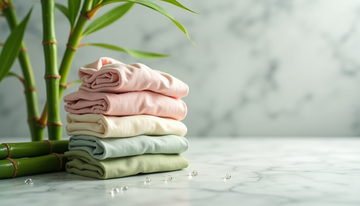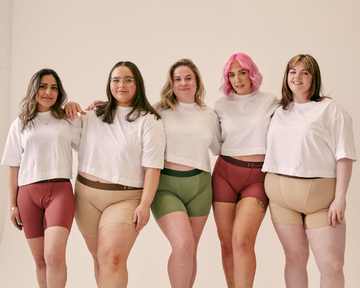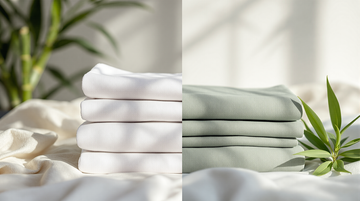Why Bamboo Underwear and Yeast Infections Are a Match Made in Heaven
 The connection between bamboo underwear and yeast infections might surprise you. Three out of four women face vaginal thrush during their lifetime, so finding ways to prevent it matters. Bamboo underwear stands out as a natural solution that breathes three times better than cotton and wicks moisture four times more effectively.
The connection between bamboo underwear and yeast infections might surprise you. Three out of four women face vaginal thrush during their lifetime, so finding ways to prevent it matters. Bamboo underwear stands out as a natural solution that breathes three times better than cotton and wicks moisture four times more effectively.
Cleaning your underwear properly becomes crucial if you get frequent infections. The right moisture-wicking underwear can transform your daily comfort and health. Bamboo fabric keeps 70% of its bacteria-fighting power even after 50 washes, which makes it perfect for preventing yeast infections. The fabric kills 99.8% of bacteria in just 24 hours and creates conditions where yeast can't easily grow.
Bamboo underwear has changed how we think about vaginal health care. This simple change to your wardrobe could give you the relief you've been looking for.
Why yeast infections happen and how underwear plays a role
Your vagina naturally keeps a delicate balance between yeast and bacteria. Learning about this balance is vital to prevent the uncomfortable itching, burning, and discharge that comes with yeast infections.
What causes yeast infections
Yeast infections happen when the fungus Candida albicans grows too much in your vagina. Good bacteria called lactobacillus work hard to stop excessive yeast growth. The careful balance can get thrown off by several things.
Antibiotics are one of the biggest culprits behind yeast infections. These drugs kill bad bacteria but also wipe out the good bacteria in your vagina, which can let yeast grow unchecked. Your hormone levels make a big difference too—pregnancy, birth control pills, and hormone therapy can boost estrogen, creating an environment where yeast runs wild.
Here are other things that raise your risk:
-
Diabetes management issues: Blood sugar that's not well controlled puts you at higher risk than managed diabetes
-
Weakened immune system: You're more likely to get infections if you have HIV or take immunity-suppressing drugs
-
Environmental factors: Staying in wet swimsuits or sweaty clothes creates perfect conditions for yeast to multiply
Your body can sometimes clear up mild yeast infections on its own, especially during your period when vaginal pH becomes more acidic and makes it harder for yeast to grow.
How fabric choice affects vaginal health
The underwear you pick can really affect your vaginal microbiome. Studies in the European Journal of Obstetrics and Gynecology and Reproductive Biology show that picking the right fabric helps prevent bacterial and yeast infections.
Cotton stands out as a top choice because it breathes well and absorbs moisture. In spite of that, materials like nylon and spandex cause trouble by keeping heat and moisture trapped—exactly what yeast loves. These non-breathable fabrics basically create a warm, damp playground for unwanted organisms.
The way your underwear fits matters just as much as the material. Tight underwear doesn't let air flow and traps moisture. Poor circulation not only helps yeast grow but can also cause irritation, chafing, and ingrown hairs. Tight underwear can even mess with your digestion and cause acid reflux and heartburn if you wear it too long.
People used to think thongs increased infection risk by moving bacteria from back to front. A 2019 study found no proof that thongs cause UTIs or yeast infections. The material and fit of the thong still matter though.
Doctors recommend breathable, natural fabrics for the best vaginal health. Bamboo tops the list, but cotton, hemp, and linen work great too. These materials help keep air moving and moisture levels right, which cuts your risk of yeast infections way down. Picking the right underwear is a simple way to help prevent infections from coming back.
Why bamboo is better than cotton and synthetics
The material of intimate apparel plays a huge role in supporting vaginal health. Bamboo fabric outperforms both traditional cotton and synthetic materials, and with good reason too.
Breathability and airflow comparison
You need proper airflow to prevent the warm, moist environment where yeast runs on. Bamboo fabric really shines here - its air permeability beats cotton by 20%. The science is fascinating - bamboo fibres contain tiny holes that create natural ventilation channels throughout the fabric.
Bamboo underwear outperforms standard cotton options in breathability - it's actually three times better. The hollow structure lets air flow freely and regulates temperature by releasing excess heat efficiently. This improved breathability makes a real difference for people prone to yeast infections.
Moisture-wicking performance
Bamboo's ability to handle moisture goes beyond just being breathable. Studies show it absorbs 60% more than cotton and can soak up three times its weight in water before feeling damp.
Bamboo works in two powerful ways to manage moisture:
-
It pulls sweat away from your skin actively
-
It moves that moisture to the surface quickly so it can evaporate
This impressive wicking comes from bamboo's unique structure that combines water-repelling lignin with water-loving carbohydrates. Tests of five leading fabrics showed bamboo had the best capillary effect, soaking up 60% more moisture than cotton. This means sensitive areas stay much drier, which helps prevent yeast infections.
Antibacterial and antifungal properties
The natural antimicrobial properties of bamboo make it a standout choice for preventing yeast infections. Bamboo plants contain a bio-agent called "bamboo kun" that fights bacteria and fungi naturally. This compound breaks down microorganisms' cellular structures to stop them from growing.
The results speak for themselves - bamboo fabric can stop up to 99.8% of bacterial growth. Lab tests prove it destroyed about 70% of bacteria in fabric samples. Unlike artificial antimicrobial treatments that wash away, bamboo's protection comes from inside the fibre.
Research points to lignin as bamboo's main antibacterial compound, with specific chemical groups doing the heavy lifting. The fabric keeps its germ-fighting and odour-controlling powers even after 50 washes.
Bamboo underwear offers natural protection that cotton just can't provide. Its superior breathability, exceptional moisture control, and built-in antimicrobial properties create conditions that don't deal very well with yeast growth. This makes bamboo underwear an excellent choice to maintain vaginal health.
How bamboo underwear helps prevent yeast infections
Bamboo underwear helps prevent recurring yeast infections. The natural properties of bamboo fabric create an environment that stops Candida growth. This makes it perfect for anyone who deals with these uncomfortable infections regularly.
Maintains a dry environment
Yeast infections love warm, damp spaces. Bamboo underwear prevents exactly these conditions. The fabric absorbs three times its weight in water, which makes it four times better at absorption than regular cotton. This happens because tiny gaps in its structure pull moisture away from your skin.
Bamboo's vertical wicking moves sweat and discharge to the outer surface where it dries fast. Your sensitive areas stay drier throughout the day. The fabric's natural temperature control adds extra protection. Studies show bamboo stays 2-3°C cooler than surrounding temperatures. This cooling makes it harder for yeast to grow by reducing the warm environment Candida needs.
Clinical research proves bamboo lets more water vapour escape compared to cotton. This stops moisture from getting trapped against your skin. When it comes to vaginal health, bamboo stands out as the top fabric choice. Its breathability and moisture control work together to keep things dry and prevent yeast overgrowth.
Reduces bacterial growth
Bamboo underwear's antibacterial qualities defend against harmful microorganisms. A natural substance called "bamboo kun" fights off microbial invasion. This bio-agent breaks down bacterial cell structures and stops them from growing.
Lab tests confirm that bamboo fabric stops bacteria from expanding. Natural compounds in bamboo fibers like flavonoids, phenols, and lignin create this antimicrobial effect.
Bamboo underwear helps people who get frequent yeast infections. Research shows bacteria can't settle into bamboo fabric's weave. Unlike synthetic materials that collect microorganisms, bamboo pushes them away. This lowers the risk of harmful bacteria reaching your vaginal area.
Supports natural pH balance
Your vaginal ecosystem needs a delicate balance to prevent yeast infections. Bamboo underwear helps keep your body's natural pH levels stable in several ways. The fabric's moisture control stops the dampness that can upset vaginal flora.
Bamboo fabric won't irritate sensitive tissues because it's hypoallergenic. The fibres have natural rounded edges that don't scratch delicate skin. This helps maintain healthy vaginal balance.
Women who often get bacterial vaginosis or thrush will find these bamboo underwear benefits helpful:
-
Makes a balanced, dry environment where yeast can't thrive
-
Keeps good bacteria and yeast ratios stable
-
Minimises irritation that weakens vaginal defenses
Bamboo underwear provides a detailed approach to preventing yeast infections. It keeps things dry, stops bacterial growth, and supports natural pH balance. The fabric creates conditions where Candida doesn't work well. Switching to bamboo underwear is a simple change that can make a big difference in vaginal health.
How to clean underwear after a yeast infection
Proper underwear hygiene is a vital part of preventing recurring yeast infections. You need to know how to clean your undergarments properly even with high-quality bamboo underwear to break the infection cycle.
Best washing practices
Regular washing alone won't kill all the yeast. High heat kills yeast, so you should wash your underwear in hot water (around 60°C/140°F). Your washing machine's "sanitise" or "extra hot" setting works best.
Gentle, hypoallergenic detergents without fragrances help prevent skin irritation. Fabric softeners can actually irritate sensitive skin, so it's best to avoid them. Standard detergent is usually enough, but adding a cup of white vinegar to the rinse cycle helps naturally curb fungi growth.
Complete drying is just as important but often gets overlooked. Yeast runs on moisture, so make sure your underwear dries completely before wearing it again. A clothes dryer on high heat gives extra protection. You can also iron your underwear to kill any remaining yeast effectively.
When to replace your underwear
Good cleaning habits won't make underwear last forever. Most experts say you should replace underwear about once a year. This might seem too often, but old underwear can trap bacteria even after washing.
Look for these signs that you need new underwear:
-
Elastic has lost its stretch or shape
-
You see holes, tears, or thin spots
-
Stains or smells stay after washing
Old fabric loses its ability to wick away moisture, which creates perfect conditions for yeast growth. This matters even more if you get frequent infections.
Avoiding cross-contamination in laundry
Cross-contamination is the biggest problem when handling underwear after a yeast infection. You should wash your underwear separately from other clothes. Laundry from someone who has an infection shouldn't mix with other people's items.
Don't shake dirty underwear before washing because bacteria can spread through the air. Make sure to clean and disinfect your hampers and any surfaces that touched contaminated laundry.
People with severe or recurring infections should wear disposable gloves while handling soiled underwear to prevent reinfection. Remember to wash your hands really well before and after touching laundry to reduce infection risks.
Choosing the right bamboo underwear for your needs
The right bamboo underwear can cut your risk of yeast infections by a lot. You'll need to think about more than just the bamboo material to boost its protective benefits.
Styles for daily wear vs workouts
Bamboo underwear comes in different styles that help prevent yeast infections in specific ways. Women’s boxers or briefs work great for everyday use and let your skin breathe while fitting comfortably. Active people just need extra features:
-
Women’s boxer briefs with longer legs stay put when you move
-
Workout designs come with anti-chafing panels that stop thigh rub
-
Performance underwear legs are longer to keep everything in place during hard workouts
Your best bet is bamboo underwear with stretch and flexibility that supports you without squeezing too tight. Brands these days offer everything from classic briefs to loose boxers or trunks so you can pick what feels right.
Fit and comfort considerations
The right fit makes bamboo underwear work better against yeast infections. Check brand-specific size guides since bamboo fabric stretches a bit to fit different body shapes.
Waistbands should sit flat without rolling or digging into your skin - this lets air flow properly. Some brands make their bamboo underwear without seams, which means no annoying hem lines that might irritate sensitive spots.
Bamboo-spandex blends are a great way to get extra stretch while keeping the moisture-wicking benefits. Bamboo's natural softness feels great on sensitive skin, which makes it perfect if you're dealing with irritation.
What to look for in product labels
Product labels will tell you if you're getting real bamboo benefits. Bamboo fabric shows up in different forms: viscose (rayon), lyocell, or blends.
Check for organic certification to know your underwear comes from sustainably grown bamboo without nasty pesticides. Good bamboo underwear labels should tell you how much bamboo is in there and if it's mixed with cotton or spandex.
The care tags usually say to wash at temperatures up to 40°C/104°F using gentle cycles and eco-friendly detergents. Skip the fabric softener because bamboo fibres naturally get softer over time.
Conclusion
Bamboo underwear works great for anyone dealing with yeast infections that keep coming back. Bamboo fabric beats cotton and synthetic materials hands down. It breathes better, wicks away moisture better, and naturally fights bacteria. These features create conditions where yeast just can't grow.
The numbers tell the story. Bamboo soaks up 70% more moisture than cotton and keeps fighting bacteria even after 50 washes. The right cleaning routine after an infection will boost your protection against future ones. Hot water washing, complete drying, and regular underwear replacement are vital steps to stop infections from coming back.
Your bamboo underwear's style and fit will give you the best results for what you need. Bamboo underwear keeps you comfortable and protected whether you're going about your day or working out. You can find Flissie boxers here if you want to try bamboo women's boxer shorts to help with yeast infections.
Three out of four women get yeast infections at some point. Now you know how switching to bamboo underwear can cut your risk by a lot. Bamboo underwear's mix of breathability, moisture control, and natural germ-fighting powers makes it perfect for keeping things healthy down there. This simple wardrobe swap might be exactly what you've been looking for - your body will love you for it.
FAQs
Q1. How does bamboo underwear help prevent yeast infections? Bamboo underwear is highly breathable, moisture-wicking, and has natural antibacterial properties. It creates a dry environment that discourages yeast growth, absorbs moisture quickly, and helps maintain the vagina's natural pH balance.
Q2. Is bamboo underwear better than cotton for vaginal health? Yes, bamboo underwear is superior to cotton for vaginal health. It's about three times more breathable, absorbs 70% more moisture, and retains antibacterial properties even after multiple washes, making it more effective at preventing conditions that lead to yeast infections.
Q3. How often should I replace my bamboo underwear? Experts recommend replacing underwear approximately every year, regardless of the material. However, you should replace them sooner if you notice loss of elasticity, visible wear and tear, or persistent odors after washing.
Q4. What's the best way to wash bamboo underwear after a yeast infection? Wash bamboo underwear in hot water (around 60°C/140°F) using a gentle, fragrance-free detergent. Adding white vinegar to the rinse cycle can provide extra protection. Ensure the underwear is completely dry before wearing, preferably using a dryer on high heat.
Q5. What should I look for when choosing bamboo underwear? Look for underwear with a high percentage of bamboo content, organic certification, and appropriate style for your needs (daily wear or workout). Ensure a proper fit with non-restrictive waistbands and consider seamless options for maximum comfort. Check the product label for specific care instructions.






